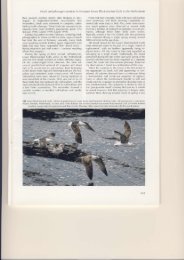Identification of American Herring Gull in a western European context
Identification of American Herring Gull in a western European context
Identification of American Herring Gull in a western European context
You also want an ePaper? Increase the reach of your titles
YUMPU automatically turns print PDFs into web optimized ePapers that Google loves.
<strong>Identification</strong> <strong>of</strong> <strong>American</strong> <strong>Herr<strong>in</strong>g</strong> <strong>Gull</strong> <strong>in</strong> a <strong>western</strong> <strong>European</strong> <strong>context</strong>to that <strong>of</strong> the lower scapulars, and very probably notoccurr<strong>in</strong>g <strong>in</strong> first-year <strong>European</strong> <strong>Herr<strong>in</strong>g</strong>.Uniformity <strong>of</strong> underparts The strik<strong>in</strong>gly smoothtextured,evenly dark underparts <strong>of</strong> many juvenilesmithsonianus (plate 1 and 4) are probably never trulymatched by <strong>European</strong> <strong>Herr<strong>in</strong>g</strong> <strong>Gull</strong>s. Sometimes,however, <strong>European</strong> birds are more evenly saturatedand darker-look<strong>in</strong>g below than usual (plate 16), so careshould be taken not to place too much importance onthis feature alone.Upperparts The pale fr<strong>in</strong>ges and notches to the upperpart-feathersaverage slightly less extensive than <strong>in</strong><strong>European</strong> <strong>Herr<strong>in</strong>g</strong> <strong>Gull</strong>, contribut<strong>in</strong>g to an overall darkerappearance. At the darker end <strong>of</strong> the range (plate 1),the patterns are probably never matched by juvenile<strong>European</strong> <strong>Herr<strong>in</strong>g</strong> but lighter smithsonianus could easilyescape detection, at least on the basis <strong>of</strong> upperpartspattern, among their <strong>European</strong> counterparts.Tertial pattern In juvenile plumage, the tertial patternis rather similar to some graellsii (and therefore unlikemost argenteus) with little notch<strong>in</strong>g which is generally‘f<strong>in</strong>er’ and is usually conf<strong>in</strong>ed to the tips <strong>of</strong> the feathers.Juvenile argentatus tertials are <strong>of</strong>ten even more extensivelypale-notched than <strong>in</strong> argenteus but, significantly,a high proportion <strong>of</strong> F<strong>in</strong>nish argentatus, which mightbe described as ‘dark type’, have much reduced palefr<strong>in</strong>ge-mark<strong>in</strong>gs, their tertials be<strong>in</strong>g similarly patternedto graellsii (plate 18).Greater-covert bar Most smithsonianus show a variableamount <strong>of</strong> solid dark-brown at the base <strong>of</strong> thegreater coverts which is clearly visible on the rest<strong>in</strong>gbird (plate 28, 36 and 37), form<strong>in</strong>g an additional ‘bar’<strong>in</strong> flight (plate 33), similar to that shown by most firstyeargraellsii. The significance <strong>of</strong> this feature has, perhaps,been over-emphasized s<strong>in</strong>ce it is by no meansexclusive to smithsonianus and is <strong>of</strong>ten shown byargentatus and sometimes by argenteus.Inner primaries On average, the <strong>in</strong>ner-primary w<strong>in</strong>dow<strong>of</strong> first- and second-year smithsonianus is slightlyduller than <strong>in</strong> <strong>European</strong> <strong>Herr<strong>in</strong>g</strong> <strong>Gull</strong>s <strong>of</strong> the same age,add<strong>in</strong>g to the uniformity <strong>of</strong> the upperw<strong>in</strong>g. While thereis usually no strong contrast between <strong>in</strong>ner and outerwebs on these feathers <strong>in</strong> either smithsonianus or<strong>European</strong> <strong>Herr<strong>in</strong>g</strong> (thus differ<strong>in</strong>g from graellsii), theground colour <strong>of</strong> the <strong>in</strong>ner primaries is rather dullbrownish grey <strong>in</strong> smithsonianus, while more pale greyish(with less <strong>of</strong> a muddy brown t<strong>in</strong>ge) <strong>in</strong> <strong>European</strong><strong>Herr<strong>in</strong>g</strong> <strong>Gull</strong>. This is not a terribly useful character, <strong>of</strong>course, but it may be <strong>of</strong> some significance <strong>in</strong> evaluat<strong>in</strong>gcontentious birds.Confusion with graellsiiThere are many similarities between juvenilesmithsonianus and dark first-year graellsii, some<strong>of</strong> which can show a confus<strong>in</strong>g comb<strong>in</strong>ation <strong>of</strong>rather dark underparts, heavily patterned rumpand uppertail-coverts and sometimes an apparently‘all-dark’ tail. Most graellsii can, however,be quickly recognized by their more lightweightbuild, narrower, more po<strong>in</strong>ted w<strong>in</strong>gs andslimmer bill than smithsonianus but, s<strong>in</strong>ce not allsmithsonianus are ‘heavyweights’ (plate 5) andsize is not always easily determ<strong>in</strong>ed, the follow<strong>in</strong>gcharacters should be checked:Lack <strong>of</strong> pale w<strong>in</strong>dow on <strong>in</strong>ner primaries Much as <strong>in</strong><strong>European</strong> <strong>Herr<strong>in</strong>g</strong> <strong>Gull</strong>, smithsonianus show a prom<strong>in</strong>entpale w<strong>in</strong>dow on the <strong>in</strong>ner primaries (plate 2and 3). In graellsii, the <strong>in</strong>ner primaries are almost asdark as the outer.Uniformity <strong>of</strong> underparts Generally, never matchedby graellsii but some <strong>of</strong> the latter are potentially confus<strong>in</strong>g(plate 17).Vent and undertail-coverts The ventral area andundertail-coverts <strong>of</strong> juvenile smithsonianus are generallymuch more densely patterned than <strong>in</strong> graellsii(plate 7).Pattern <strong>of</strong> rump and uppertail-coverts Most graellsiishow an obviously whitish rump contrast<strong>in</strong>g witha black tail-band but a few show a pattern and density<strong>of</strong> mark<strong>in</strong>gs that is undeniably close to that <strong>of</strong> lessheavily marked smithsonianus. It is all-too-easy, whenconcentrat<strong>in</strong>g too much on this one feature, to overlookthe other identification clues and mistake suchdark graellsii for smithsonianus.First-w<strong>in</strong>ter (plate 24-58, figure 1)With more than 90% <strong>of</strong> the records <strong>of</strong> smithsonianus<strong>in</strong> Europe be<strong>in</strong>g made up <strong>of</strong> birds <strong>in</strong> firstw<strong>in</strong>terplumage, this is certa<strong>in</strong>ly the bestrepresentedplumage type on the <strong>European</strong> side<strong>of</strong> the Atlantic. At least <strong>in</strong> Ireland, where the vastmajority <strong>of</strong> <strong>European</strong> <strong>Herr<strong>in</strong>g</strong> <strong>Gull</strong>s are <strong>of</strong> thepaler argenteus type, first-w<strong>in</strong>ter smithsonianuscan be rather conspicuous amongst a mid-w<strong>in</strong>tergull flock. Smithsonianus appears to exhibit evenmore <strong>in</strong>dividual variation than argenteus <strong>of</strong> thesame age but even so, we had difficulty f<strong>in</strong>d<strong>in</strong>gbirds <strong>in</strong> the eastern USA that would not attractsome attention <strong>in</strong> a rout<strong>in</strong>e search <strong>of</strong> a gull flockon the <strong>European</strong> side <strong>of</strong> the Atlantic.Many <strong>of</strong> the characters which help differentiatejuvenile smithsonianus and <strong>European</strong> <strong>Herr<strong>in</strong>g</strong><strong>Gull</strong>s, most notably those relat<strong>in</strong>g to the upperandundertail-coverts, w<strong>in</strong>gs and tail, rema<strong>in</strong>essentially unchanged <strong>in</strong> first-w<strong>in</strong>ters and thereforedo not need to be repeated here. Additionalcharacters on which to concentrate whenconfronted with a possible first-w<strong>in</strong>ter smithsonianus<strong>in</strong>clude:Uniformity <strong>of</strong> underparts By mid-w<strong>in</strong>ter, many firstyearsmithsonianus are a little faded and less evenlydark than they would have been as juveniles but are stillmore uniform below than the great majority <strong>of</strong><strong>European</strong> <strong>Herr<strong>in</strong>g</strong> <strong>Gull</strong>s. The latter generally have paler,more mottled or streaked underparts but can occasion-11










